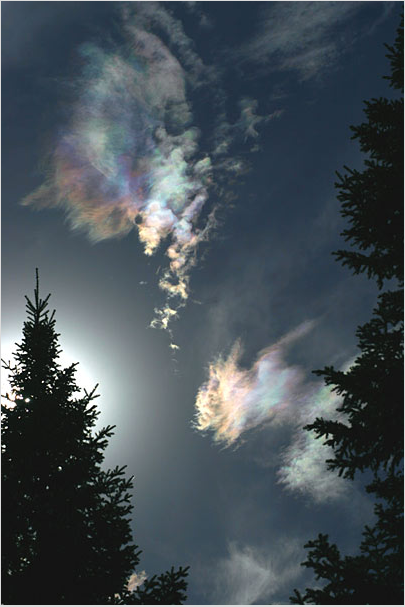Iridescent Clouds
Iridescent Clouds: Nature's Colorful Masterpieces
Have you ever looked up at the sky and been captivated by the mesmerizing colors dancing within the clouds? These enchanting displays are known as iridescent clouds, and they are truly a sight to behold. In this article, we will delve into the captivating world of iridescence, exploring what causes these ethereal colors, where and when they are most likely to appear, and the different forms they can take.
What Causes Iridescent Clouds?
Iridescent clouds are a result of the interaction between sunlight and tiny water droplets or ice crystals in the atmosphere. When light passes through these minuscule particles, it undergoes a process called diffraction. This causes the light waves to scatter and interfere with each other, resulting in the creation of vibrant colors. The colors we see in iridescent clouds are similar to those produced by a prism, where white light is separated into its constituent colors.
Optimal Viewing Conditions
To witness the enchanting beauty of iridescent clouds, it is best to look for them near a well-shielded sun. This positioning allows the sunlight to interact with the water droplets or ice crystals in a way that maximizes the iridescent effect. The irregular patterns of colors seen in iridescent clouds can also take on other forms, such as bands or even start to resemble a corona.
The Role of Water Droplets and Ice Crystals
Water droplets and ice crystals play a crucial role in the formation of iridescent clouds. These particles act as tiny prisms, refracting and diffracting sunlight to produce the stunning display of colors. The size and shape of the particles, as well as their distribution within the cloud, can influence the appearance of the iridescence. Larger particles tend to produce broader bands of colors, while smaller particles may create more intricate and detailed patterns.
When and Where to Spot Iridescent Clouds
Iridescent clouds can occur in a variety of weather conditions, but they are most commonly observed when there are thin, high-altitude clouds present. These clouds, known as cirrus clouds, are composed of ice crystals and often form in the upper levels of the troposphere. The best time to look for iridescent clouds is during the early morning or late afternoon when the sun is low on the horizon. This angle of sunlight creates the optimal conditions for the iridescent colors to manifest.
Other Phenomena Associated with Iridescence
While iridescent clouds are the most well-known manifestation of iridescence in the sky, there are other related phenomena that can occur. These include iridescent halos around the sun or moon, as well as iridescent coronas that encircle these celestial bodies. These phenomena occur when light is diffracted by ice crystals in the atmosphere, creating a stunning display of colors around the sun or moon.
The Magic of Nature's Palette
The colors observed in iridescent clouds can vary widely, ranging from soft pastels to vivid hues. The specific colors seen depend on various factors, including the size and shape of the particles, the angle of the sunlight, and the observer's position. Common colors include shades of blue, green, pink, purple, and orange. The ever-changing nature of iridescence makes each sighting a unique and awe-inspiring experience.
Cultural Significance and Symbolism
Throughout history, iridescent clouds have captivated and inspired people across cultures. In many ancient civilizations, these colorful displays were believed to hold spiritual or mystical significance. They were often seen as omens or messages from the gods. Even today, many cultures associate iridescent clouds with good fortune, creativity, and positive energy. Witnessing the beauty of iridescence can be a powerful and uplifting experience, connecting us to the wonders of the natural world.
Capturing the Magic: Photography Tips
If you're fortunate enough to spot iridescent clouds, you may want to capture their beauty through photography. Here are a few tips to help you capture the magic:
- Use a polarizing filter to enhance the colors and reduce glare.
- Experiment with different angles and compositions to find the most visually striking shots.
- Pay attention to the lighting conditions and adjust your camera settings accordingly.
- Consider including elements of the landscape or other objects to add depth and context to your photos.
- Don't be afraid to get creative and experiment with long exposures or multiple exposures to capture the dynamic nature of iridescence.
Cherishing the Transient Beauty
Iridescent clouds are fleeting and ephemeral, appearing for only brief moments before dissipating into the sky. Their transient nature adds to their allure, reminding us of the ever-changing and impermanent nature of our world. So, next time you find yourself gazing at the sky, take a moment to look for these ethereal masterpieces. Marvel at the kaleidoscope of colors suspended above you, and let the beauty of iridescence ignite a sense of wonder and appreciation for the intricate wonders of our atmosphere.

Irregular iridescence September 2004 at Walker Michigan taken by Russ Hansen.
This image shows well that iridescence is best looked for near to a well shielded sun. Here the colours are irregular but they can also be banded or starting to take the form of a corona.
Image ©2004 Russ Hansen, shown with permission.
Note: this article has been automatically converted from the old site and may not appear as intended. You can find the original article here.
Reference Atmospheric Optics
If you use any of the definitions, information, or data presented on Atmospheric Optics, please copy the link or reference below to properly credit us as the reference source. Thank you!
-
<a href="https://atoptics.co.uk/blog/iridescent-clouds-5/">Iridescent Clouds</a>
-
"Iridescent Clouds". Atmospheric Optics. Accessed on November 26, 2024. https://atoptics.co.uk/blog/iridescent-clouds-5/.
-
"Iridescent Clouds". Atmospheric Optics, https://atoptics.co.uk/blog/iridescent-clouds-5/. Accessed 26 November, 2024
-
Iridescent Clouds. Atmospheric Optics. Retrieved from https://atoptics.co.uk/blog/iridescent-clouds-5/.